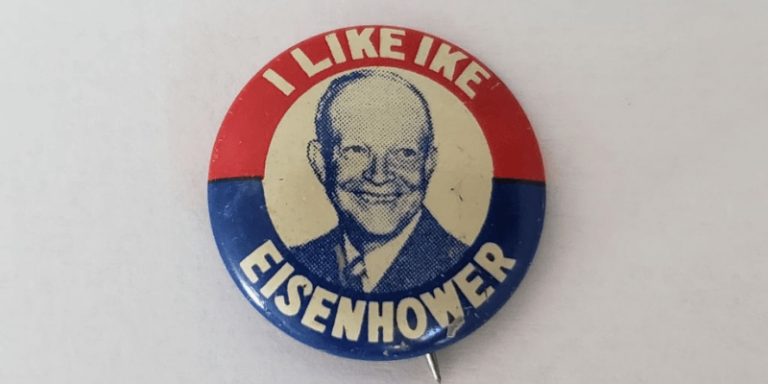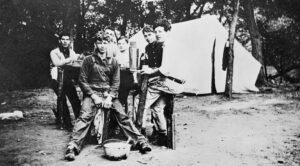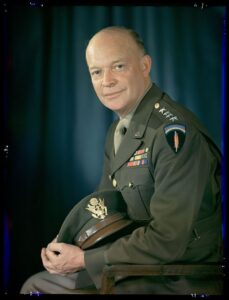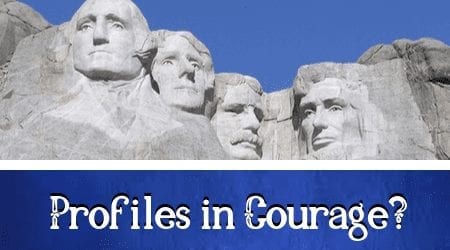Dwight D. Eisenhower: From General to President
“Ike” was instrumental in commanding troops towards an Allied win.
By: Kelli Ballard | June 29, 2021 | 641 Words

(Photo by Smith Collection/Gado/Getty Images)
Dwight David Eisenhower (1890 – 1969) was the 34th president of the United States. Eisenhower had been a general during World War II and was one of the few who opposed using the atomic bomb at Hiroshima and Nagasaki.
Early Life and Military
Eisenhower was born on October 14, 1890, in Denison, Texas. He was the third of seven sons. His mother, a devout Mennonite, was upset when her son won an appointment to West Point, a military academy in New York. Ike graduated in 1915 and was getting ready to go to Europe when World War I ended, which canceled his deployment.

As a young teenage boy, President Dwight D Eisenhower sits front center wearing overalls, sitting with a group of boys during a camping trip. Image courtesy National Archives. (Photo via Smith Collection/Gado/Getty Images)
That didn’t derail his military career, though. He soon joined the Command and General Staff College at Fort Leavenworth, Kansas, and then served as a military aide to General John J. Pershing, who was commander of U.S. forces during WWI. After that, he served under General Douglas MacArthur, U.S. Army chief of staff. He was stationed in the Philippines from 1935 to 1939 but returned home after Nazi Germany invaded Poland, which started World War II in Europe.
Eisenhower received his first general’s star in September 1941, just two months before Japan attacked Pearl Harbor. After the attack, he was called to head Operation Torch, an invasion of North Africa. He then directed the amphibious invasion of Sicily and the Italian mainland in 1943, which led to the June 1944 fall of Rome.

(Photo by SSPL/Getty Images)
By 1943, Eisenhower had made full general and became the supreme commander of the Allied Expeditionary Force, whose duty was to invade Nazi-occupied Europe. On June 6, 1944, known as D-Day, more than 150,000 Allied forces crossed the English Channel to storm the beaches of Normandy. This action turned the tide of the war, with victory coming soon after. Eisenhower became the chief of staff of the Army in 1945.
Politics and Presidency
In 1950, President Harry S. Truman asked Eisenhower to command the North Atlantic Treaty Organization (NATO), a group of nations who agreed to work together in military defence. In 1952, the Republicans asked him to run for president. Using the slogan “I Like Ike,” Eisenhower ran with Richard Nixon as his running mate and became the 34th president of the United States, serving two terms.
 A moderate Republican, Eisenhower had many legislative wins even though Democrats held the majority in Congress for six of his eight years in office. He continued Franklin Roosevelt’s New Deal and Truman’s Fair Deal programs. He also strengthened the Social Security program, created the Department of Health, Education and Welfare, and increased the minimum wage. In 1956, Eisenhower took on the single largest public works program in U.S. history, creating the Interstate Highway System, which built 41,000 miles of roads across the country.
A moderate Republican, Eisenhower had many legislative wins even though Democrats held the majority in Congress for six of his eight years in office. He continued Franklin Roosevelt’s New Deal and Truman’s Fair Deal programs. He also strengthened the Social Security program, created the Department of Health, Education and Welfare, and increased the minimum wage. In 1956, Eisenhower took on the single largest public works program in U.S. history, creating the Interstate Highway System, which built 41,000 miles of roads across the country.
Eisenhower was a cautious commander who often took a backseat to observe and work behind the curtain on controversial topics. For example, Senator Joseph McCarthy, a Republican, went on an anti-Communist crusade that violated some citizens’ civil liberties. Publicly, the president did nothing; however, he still was able to dim the senator’s influence and eventually discredit him.
Civil Rights for black Americans was another touchy subject for Eisenhower, who believed the process of desegregation should be slow and steady. He was reluctant to use his presidential powers but on the issue, he did send troops to Little Rock, Arkansas in 1957 to enforce integration at a local high school, and he signed civil rights legislation in 1957 and 1960 to protect black voters. These were the first laws of their kind passed in the U.S. since shortly after the Civil War.
















